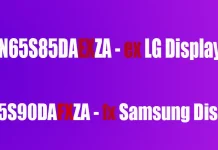Sceptre TV is quite a popular brand of modern TVs. Today it competes with such giants of electronics as Samsung, LG, and others. In addition, Sceptre TV offers its users the same and additional unique features. One such feature is the ability to watch TV with subtitles.
Subtitle display in general is a very convenient tool that allows some categories of users to simplify watching video content. For this reason, almost all models of modern TVs are equipped with such functionality. Of course, subtitles can bother many users, but in most cases, they only benefit people. In any case, if someone doesn’t want subtitles, you can always turn them off. So, if you need to turn off subtitles on your Sceptre TV, here’s how you can do it.
How do subtitles work?
When a new film comes out, it’s not easy to get it translated. It’s even more difficult to dub it in the native language, so new films are often subtitled first, and only then comes dubbing. Although many movie lovers prefer to watch it in its original language to feel the emotions and performance of the actors. Some people improve their knowledge of a foreign language because there’s no better practice than listening to native speakers.
In addition, subtitles are the only option for people with hearing difficulties. Finally, subtitles can be present as a way of dubbing TV programs in the national language.
Subtitle control on most modern TVs, including Sceptre TVs, is as simple as possible. It’s possible to change the display status with a few clicks using the remote control buttons. For example, you can easily turn off subtitles on Hisense TV too. However, the problem is that, firstly, many people simply don’t know about this possibility. Secondly, there’s no generally accepted standard in this matter, and each manufacturer solves the problem in its way.
- How to change the input source on Sceptre TV without remote
- Why do you see closed captioning instead of subtitles on your Sceptre TV
- How to get Sceptre TV out of Demo Mode or Store Mode
How to disable subtitles on your Sceptre TV
There are times in life when you turn on your TV and wonder about certain things. For example, you may find that your screen displays subtitles when you watch movies or TV shows. Chances are, you didn’t turn them on. You might have turned them on by accident. However, it doesn’t matter what the reason is. The important thing is that you can turn them off just like the voice guide, and here’s how:
- First of all, turn on your Sceptre TV using your remote control and click on the “CC” button.
- After that, a new window with the closed captioning settings will appear on your TV screen.
- Finally, just select the “OFF” option using your remote control to disable subtitles on your Sceptre TV.
Once you have completed these steps, you will be able to disable closed captioning on your Sceptre TV. As you can see, it’s very simple to do this on your Sceptre TV. You have also to be aware that if you have any problems with your Sceptre TV and it works unproperly, you can always contact Sceptre support and they will help you.
What does closed captioning mean?
Many users think and believe that closed captioning and subtitles are the same thing, but this is far from the case. Nowadays, many streaming services support closed captioning and subtitles, so if you need to enable subtitles on Disney Plus, you can do so quite easily.
Subtitles aren’t designed to help people learn a foreign language. The main purpose of subtitles is to help people with hearing impairments. In this way, you can see not only the text that’s displayed when the audio track is broadcast, but you can also see other events and details that are happening and are displayed on the screen.
Today, many services have incorporated closed captioning into their system, allowing people with hearing difficulties to fully participate in the process. TikTok is one such service that adds automatic closed captioning.
What is the difference between open and closed captions?
Subtitles are either open or closed captioned. The former is encoded in the video, while the latter exists as a separate file. The open ones are always on the screen and are an integral part of the movie or TV show. They are also called “hardcoded” or “stitched”.
Hidden subtitles can be turned off. They are added to the video stream as text or images. A separate type of subtitles is pre-rendered subtitles which are encoded as images. They’re used on DVD and Blu-ray.
Open captioning doesn’t require any special equipment or technology as the only requirement is for the client device to be able to play the video. However, for closed captioning, you need a player with the right format.
Read Also:
- How to turn on subtitles on Samsung TV
- Does Hisense TV have Bluetooth
- How to change the source on Hisense Smart TV
What is real-time captioning?
In the traditional sense, this is the process of converting audio into plain text, often known as real-time captioning. Transcribers listened to the audio recording and typed what they heard, and in many cases, this is still the case.
Closed captioning is not the same as transcription, since the latter is precisely synchronized with the audio. Transcriptions are simply a document that contains all the transcribed text. The source text is the words spoken throughout the video or audio clip, with no temporal coding.
However, technological advances have made live transcription possible. Live transcription can convert voice to text in real-time. This is very useful in situations where it is time-consuming to create proper captions.
Thus, live captioning cannot guarantee the same level of accuracy as closed captioning. The accuracy of any live transcription is usually determined by several variables, such as:
- Speech clarity
- Background noise
- Speech volume
- Accents and dialects
And as real-time captioning technology continues to evolve, accuracy gets better over time.






